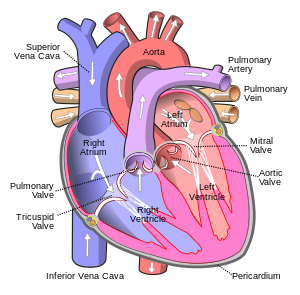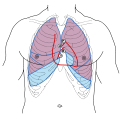Pulmonary valve
| Pulmonary valve | |
|---|---|
 Anterior (frontal) view of the opened heart. White arrows indicate normal blood flow. | |
 Heart seen from above. | |
| Details | |
| Identifiers | |
| Latin | valva trunci pulmonalis |
| MeSH | D011664 |
| TA98 | A12.1.02.010 |
| TA2 | 4008 |
| FMA | 7246 |
| Anatomical terminology | |
The pulmonary valve (sometimes referred to as the pulmonic valve) is the semilunar valve of the heart that lies between the right ventricle and the pulmonary artery and has three cusps. Similar to the aortic valve, the pulmonary valve opens in ventricular systole, when the pressure in the right ventricle rises above the pressure in the pulmonary artery. At the end of ventricular systole, when the pressure in the right ventricle falls rapidly, the pressure in the pulmonary artery will close the pulmonary valve.
The closure of the pulmonary valve contributes the P2 component of the second heart sound (S2). The right heart is a low-pressure system, so the P2 component of the second heart sound is usually softer than the A2 component of the second heart sound. However, it is physiologically normal in some young people to hear both components separated during inhalation.
Additional images
-
Interior of right side of heart.
-
Pulmonary valves
-
Pulmonary valves
See also
External links
 Media related to Pulmonary valve at Wikimedia Commons
Media related to Pulmonary valve at Wikimedia Commons- Anatomy figure: 20:07-00 at Human Anatomy Online, SUNY Downstate Medical Center
- Adult Congenital Surgery: Pulmonary Valve Replacement




